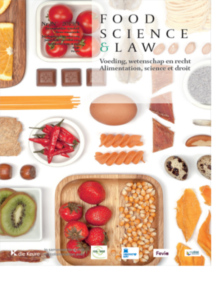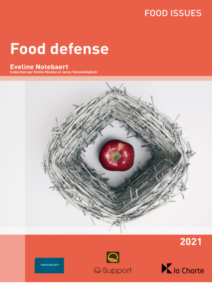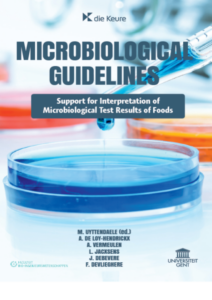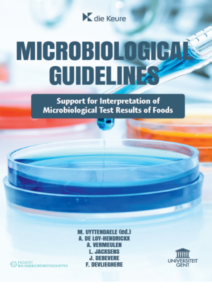| Food Science & Law (FSL) - jaargang 2024 Revue Voedingsmiddelen, de technologieën en de warenwetgeving evolueren razendsnel, zowel op nationaal als op Europees niveau. Wilt u op de hoogte blijven van alles wat leeft in de wereld van voedselveiligheid, kwaliteitsbewaking, innovatie en reglementering rond voedingsmiddelen? Dan is een abonnement op dit tweetalig tijdschrift Food Science & Law (al dan niet in combinatie met Warenwetgeving Online) voor u de perfecte oplossing. Met vier nummers per jaar blijft u steeds mee met alle veranderingen binnen dit vakgebied. Een jaarabonnement op FSL bevat:
Info over de redactie, toegang tot de bijhorende digitale platformen en een inkijkexemplaar kan u hier raadplegen. Wenst u zich te abonneren en dit tijdschrift op een adres buiten België te ontvangen? Contacteer ons op abonnementen@diekeure.be en wij bezorgen u de prijs met aangepaste portkosten. 2024 | €178 | |
| Food Defense (FR) Livre Depuis longtemps déjà, les entreprises de la chaîne alimentaire sont confrontées à des problèmes de food defense. Des individus ou des groupes malintentionnés peuvent d’ailleurs considérablement compliquer les opérations commerciales, de manière générale. Étant donné que chaque entreprise du secteur alimentaire est responsable des produits qu’elle met sur le marché, il convient également de réagir lorsqu’une action délibérée engendre un problème de sécurité alimentaire. Entretemps, de nombreuses entreprises de la chaîne alimentaire se sont mises au travail, dans le but de protéger leurs produits et leurs processus de production, mais aussi leurs infrastructures, leur image, etc. Ce livre est un guide pour tous ceux qui veulent prendre une longueur d’avance sur les saboteurs. Outre un certain nombre de clarifications concernant la définition de food défense et son évolution dans le temps, ce livre sert principalement de source d’inspiration pour effectuer sa propre analyse des risques, en identifiant les menaces et les vulnérabilités, afin d’aboutir, finalement, à un ensemble de mesures offrant une meilleure protection. Enfin, une série de mesures de protection sont également abordées. 2021 Notebaert Eveline | €55 Disponible | |
| Microbiological guidelines Livre Microbiological Guidelines: Support for Interpretation of Microbiological Test Results of Foods. Food should be tasty, healthy, sustainable and preferably not too expensive. But food should also be safe and with sufficient guarantees on maintaining good quality aspects until the end-of-shelf life. The various actors in the food supply chain have an interest in verifying the expected quality and safety by means of microbiological analyses of food. Measurement brings knowledge and microbiological guidelines help in the decision-making process for judging the acceptability of food or food production processes. The present handbook provides microbiological guidelines and current applicable EU legal criteria (status 1.1.2018) for a wide range of food categories (dairy, meat, seafoods, plant-based foods, bakery products, composite foods, shelf-stable food, water) and subcategories therein, based upon the type of food processing and intrinsic characteristics of the foods. This book can be consulted to provide quick answers on the expected microbiological contamination of foodstuff. It can help in interpretation of test results in assessing good (hygienic) practices in the production of food, determining the shelf life and ensuring food safety. The handbook also presents definitions of the wide variety of foodstuffs available and some reflections on, in particular, food safety issues or the on-going debate for some food items in assessing microbial quality. Furthermore, dedicated chapters deal with basic information on the various microbial parameters useful in testing of foods, sampling is discussed, and the set-up of challenge testing as a tool to assess food safety is elaborated upon. 2018 Uyttendaele Mieke | €95 | |
| Microbiological Guidelines (e-book) E-book Microbiological Guidelines: Support for Interpretation of Microbiological Test Results of Foods.
Food should be tasty, healthy, sustainable and preferably not too expensive. But food should also be safe and with sufficient guarantees on maintaining good quality aspects until the end-of-shelf life. The various actors in the food supply chain have an interest in verifying the expected quality and safety by means of microbiological analyses of food. Measurement brings knowledge and microbiological guidelines help in the decision-making process for judging the acceptability of food or food production processes. The present handbook provides microbiological guidelines and current applicable EU legal criteria (status 1.1.2018) for a wide range of food categories (dairy, meat, seafoods, plant-based foods, bakery products, composite foods, shelf-stable food, water) and subcategories therein, based upon the type of food processing and intrinsic characteristics of the foods. This book can be consulted to provide quick answers on the expected microbiological contamination of foodstuff. It can help in interpretation of test results in assessing good (hygienic) practices in the production of food, determining the shelf life and ensuring food safety. The handbook also presents definitions of the wide variety of foodstuffs available and some reflections on, in particular, food safety issues or the on-going debate for some food items in assessing microbial quality. Furthermore, dedicated chapters deal with basic information on the various microbial parameters useful in testing of foods, sampling is discussed, and the set-up of challenge testing as a tool to assess food safety is elaborated upon. 2018 De Loy Hendrickx Anja, Debevere Johan, ... | €95 |
Restez au courant des nouvelles publications, des promotions et des formations. S’abonner à la lettre d’information.




